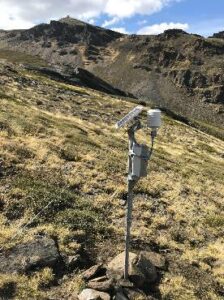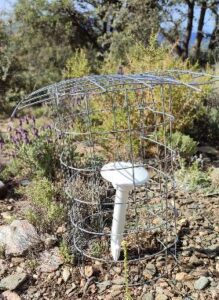


Currently, the Ecology Laboratory of the center has an intensive monitoring network of Sierra Nevada with more than 800 measurement points at different scales oriented to the observation of various aspects that directly affect climate change. This system uses Internet of Things (IoT) technologies and allows real-time monitoring of various parameters, including temperature and humidity at different levels. The manifest uniqueness of this infrastructure is accredited by its granularity and immediacy, since the data is processed in real time. There are no other networks that monitor climatic phenomena so intensively, both spatially and temporally, in environments as adverse as those of the mountains.

This network integrates stations of different types that allow measurements ranging from the macroscopic scale (precise environmental measurement) to the microscopic scale (measurement in different ecosystem types at different levels).
IoT micro-station: humidity and temperature are measured in four microhabitats: 1) Temperature and VWC at 40 cm below ground, 2) Temperature at the bare soil surface, 3) Temperature at the soil surface, but protected by: a) under stone in forest clearing, or b) under leaf litter in oak forest or high mountain scrub and 4) Temperature and air humidity (80-100 cm above ground).
Static micro-station: It measures temperature at 3 different levels and also measures soil moisture. It is mainly used to measure soil moisture and temperature at a depth of -6, +2 and +15 cm.
Perimeter recording: Temperature measurement at different points of interest.
The wide variety of sensors placed at different altitudes and locations provide accurate data on temperature and humidity. These data can be used to model weather patterns, predict extreme events and assess the impact of climate change at different levels:
Climate Change and Climate Variability:
Mountains are particularly sensitive to the effects of climate change. Climate variability in these areas can affect biodiversity, glaciers, ecosystems and water resources.
Constant measurement of temperature and humidity allows us to better understand climate trends and assess how weather patterns are changing in the mountains.
Temperature and humidity are key climate indicators. By monitoring these parameters, we can detect changes over time.
Impact on Biodiversity and Ecosystems:
Plant and animal species in the mountains are adapted to specific temperature and humidity conditions. Any alteration can affect their survival.
Variation in humidity can influence the distribution of species and the health of ecosystems. For example, prolonged drought can affect local vegetation and fauna.
Management of Protected Spaces:
Protected areas, such as national parks or nature reserves, require proper management to preserve their ecological value.
Temperature and humidity measurements help managers of protected areas make informed decisions about habitat conservation and restoration.
It can help identify vulnerable areas and prioritize conservation actions.
In summary, our Ecology laboratory currently has a unique deployment of sensors for biodiversity monitoring and tracking. This monitoring, together with digital infrastructure services and virtual research environments (VLABS), is developing new tools and services that enhance the preservation, knowledge and enhancement of biodiversity in mountain ecosystems. Specifically, the deployment of sensors monitors microclimatic conditions, aerosol deposition and associated biotic responses generated in certain mountain habitats, with high spatial and temporal resolution. This continuous monitoring, together with periodic field sampling of biotic variables (plant biodiversity, macroinvertebrates, nutrients, decomposition, greenhouse gas emissions, etc.) forms a novel intelligent monitoring framework by integrating automatic stations, field sampling and high and medium spatial-temporal resolution remote sensing and incorporating advanced analysis techniques using artificial intelligence. This deployment allows us to develop essential indicators of great interest for the diagnosis of the state of health of mountain ecosystems, the development of adaptive management projects and the valorization of the services provided by biodiversity.
Contact Person:
Regino Zamora Rodríguez Email: rzamora@ugr.es Telf. 958.243242